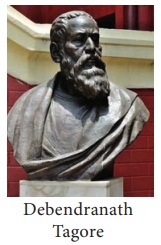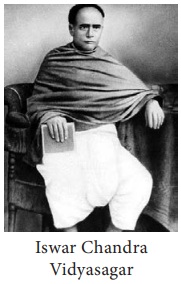Social and Religious Reform Movements in the 19th Century - Early Reform Movements in Bengal | 10th Social Science : History : Chapter 5 : Social and Religious Reform Movements in the 19th Century
Chapter: 10th Social Science : History : Chapter 5 : Social and Religious Reform Movements in the 19th Century
Early Reform Movements in Bengal
Early Reform Movements in Bengal
(a) Raja Rammohan Roy and Brahmo Samaj
Rammohan
Roy (1772–1833) was one of the earlier reformers influenced by the Western
ideas to initiate reforms. He was a great scholar, well-versed in Sanskrit,
Arabic, Persian, and English apart from his knowledge in his mother tongue,
Bengali. Rammohan Roy was opposed to meaningless religious ceremonies and all
forms of pernicious social customs. Yet he wanted to preserve continuity with
the past. In his religio–philosophical social outlook, he was deeply influenced
by monotheism and anti-idolatry. Based on his interpretation of the Upanishads,
he argued that all the ancient texts of the Hindus preached monotheism or
worship of one God.

Deeply
concerned with the prevailing customs of sati, child marriage, and polygamy he
published tracts against them and petitioned the government to legislate
against them. He advocated
the rights of widows to remarry. He wanted polygamy to end. He appealed to
reason and humanity and compassion of the people. His campaign played a key role in forcing the
Governor-General William Bentinck’s legislation abolishing sati in 1829.
Rammohan Roy condemned the subjugation of women and opposed the
prevailing ideas that women were inferior to men. He strongly advocated education for women. He gave his full support for the introduction of
English language and western sciences in schools and colleges.
Rammohan Roy founded the Brahmo Samaj on 20 August 1828. He
opened a temple in Calcutta, where there was no image. There he laid down that
‘no religion should be reviled or slightly or contemptuously spoken off or
alluded to.’ The Samaj forbade idol -worship and condemned meaningless
religious rites and ceremonies. However, from the beginning,
the appeal of the Brahmo Samaj remained
limited to the intellectuals and enlightened Bengalis. Though the Samaj failed
to attract the people from the lower sections of society, its impact on the
culture of modern Bengal and its middle class was quite significant.
(b) Maharishi Debendranath Tagore
After the death of Rammohan Roy (1833), Maharishi Debendranath Tagore (1817–1905), the poet Rabindranath Tagore’s father, carried on the work. He laid down four articles of faith:
1. In the
beginning there was nothing. The one Supreme Being alone existed who created
the Universe.
2. He
alone is the God of Truth, Infinite Wisdom, Goodness, and Power, eternal,
omnipresent, the One without second.
3. Our
salvation depends on belief in Him and in His worship in this world and the
next.
4. Belief
consists in loving Him and doing His will.

(c) Keshab Chandra Sen & Brahmo Samaj of India
Debendranath
was a moderate reformer. But his younger colleagues in the Sabha were for rapid
changes. The greatest of these, Keshab Chandra Sen, (1838–84) joined the
movement in 1857. But in 1866 a split occurred in the ranks of Keshab Chandra
Sen Brahmo Samaj. Keshab left the Samaj and founded a new organization.
Debendranath’s organization, thereafter, came to be known as Adi Brahmo Samaj.
After Keshab had his fourteen-year-old daughter married to an Indian prince, in
contravention of the Samaj’s condemnation of child marriages, the opponents of
child marriage left the Brahmo Samaj of India and started the Sadharan Samaj.

(d) Ishwar Chandra Vidyasagar
Another
outstanding reformer in Bengal was Ishwar Chandra Vidyasagar (1820–1891).

While Ram
Mohan Roy and others looked to western rationalist ideas to reform society,
Vidyasagar argued that the Hindu scriptures were progressive. He provided
evidence from scriptures that there was no sanction for burning of widows or
for the prohibition on the remarriage of widows. He wrote a number of polemical
tracts, and was the pioneer of modern Bengali prose. He played a leading role
in promoting education of girls and helped them in setting up a number of
schools. He dedicated his whole life for the betterment of the child widows of
the Hindu society. The movement led by Vidyasagar, resulted in the Widows’
Remarriage Reform Act of 1856. This Act was intended to improve the lot of
child widows and save them from perpetual widowhood.
It was also to the credit of Vidyasagar that the first age of
consent was included in the Indian Penal code, which was enacted in 1860. The
age for marriage was fixed as ten years. It was raised to twelve and thirteen
years in 1891 and 1925 respectively. Sadly, as reported in the Age of Consent
Committee (1929), the law remained on paper and the knowledge of it was
confined to judges, lawyers and a few educated men.
(e) Prarthana Samaj
The
Maharashtra region was another region where reform activities gained steam. A
movement similar to the Brahmo Samaj, but founded in Bombay in 1867, was
Prarthana Samaj. Its founder was Dr. Atma Ram Pandurang (1825–1898). The two
distinguished members of this Samaj were R.C. Bhandarkar and Justice Mahadev
Govind Ranade. They devoted themselves to activities such as inter-caste
dining, inter-caste marriage, widow remarriage and improvement of women and
depressed classes. Ranade (1842–1901) was the founder of the Widow Marriage
Association (1861), the Poona Sarvajanik Sabha (1870) and the Deccan Education
Society (1884).

Related Topics